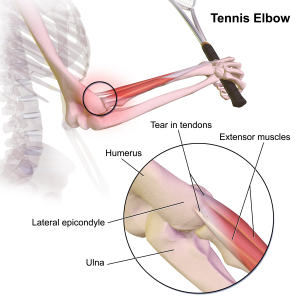Sports Injuries
Tennis Elbow (Lateral Epicondylitis)
Tennis elbow is a type of tendinitis — swelling of the tendons — that causes pain in the elbow and arm. These tendons are bands of tough tissue that connect the muscles of your lower arm to the bone. Despite its name, you can still get tennis elbow even if you’ve never been near a tennis court. Instead, any repetitive gripping activities, especially if they use the thumb and first two fingers, may contribute to tennis elbow. Tennis elbow is the most common reason that people see their doctors for elbow pain. It can pop up in people of any age, but it’s most common at about age 40.
The Causes of Tennis Elbow
Tennis elbow usually develops over time. Repetitive motions — like gripping a racket during a swing — can strain the muscles and put too much stress on the tendons. That constant tugging can eventually cause microscopic tears in the tissue.
Tennis elbow might result from:
- Tennis
- Racquetball
- Squash
- Fencing
- Weight lifting
It can also affect people with jobs or hobbies that require repetitive arm movements or gripping such as:
- Carpentry
- Typing
- Painting
- Raking
- Knitting
Symptoms of Tennis Elbow
The symptoms of tennis elbow include pain and tenderness in the bony knob on the outside of your elbow. This knob is where the injured tendons connect to the bone. The pain may also radiate into the upper or lower arm. Although the damage is in the elbow, you’re likely to hurt when doing things with your hands.
Tennis elbow may cause the most pain when you:
- Lift something
- Make a fist or grip an object, such as a tennis racket
- Open a door or shake hands
- Raise your hand or straighten your wrist
Tennis elbow is similar to another condition called golfer’s elbow, which affects the tendons on the inside of the elbow.
To diagnose your tennis elbow, your doctor will do a thorough exam. He or she will want you to flex your arm, wrist, and elbow to see where it hurts. You may also need imaging tests, such as an X-ray or MRI (magnetic resonance imaging) to diagnose tennis elbow or rule out other problems.
Treatment for Tennis Elbow
The good news about treatment is that usually tennis elbow will heal on its own. You just need to give your elbow a break and do what you can to speed the healing. Types of treatment that help are:
- Icing the elbow to reduce pain and swelling. Experts recommend doing it for 20 to 30 minutes every 3 to 4 hours for 2 to 3 days or until the pain is gone.
- Using an elbow strap to protect the injured tendon from further strain.
- Taking nonsteroidal anti-inflammatory (NSAIDs), such as ibuprofen, naproxen, or aspirin, to help with pain and swelling. However, these drugs can cause side effects, such as bleeding and ulcers. You should only use them occasionally, unless your doctor says otherwise, since they may delay healing.
- Performing range of motion exercises to reduce stiffness and increase flexibility. Your doctor may recommend that you do them three to five times a day.
- Getting physical therapy to strengthen and stretch the muscles.
- Having injections of steroids or painkillers to temporarily ease some of the swelling and pain around the joint. Studies suggest that steroid injections don’t help in the long term.
Most of the time, these treatments will do the trick. But if you have a severe case of tennis elbow that doesn’t respond to two to four months of conservative treatment, you may need surgery. In the procedure, the damaged section of tendon usually is removed and the remaining tendon repaired. Surgery works in about 85%-90% of cases.
Recovering from Tennis Elbow
Of course, what you really want to know is when you can get back to your regular activities after having tennis elbow. That depends on your individual case and the extent of the damage to the tendon. People heal at different rates.
Whatever you do, don’t rush your recovery. If you start pushing yourself before your tennis elbow is healed, you could make the damage worse. You are ready to return to your former level of activity when:
- Gripping objects or bearing weight on your arm or elbow is no longer painful.
- Your injured elbow feels as strong as your other elbow.
- Your elbow is no longer swollen.
- You can flex and move the elbow without any trouble.
How to Prevent Tennis Elbow
The key to preventing tennis elbow is to avoid overuse. Stop if you feel any elbow pain during an activity.
You may also bring on tennis elbow by using the wrong equipment, like a golf club or tennis racket that is too heavy or that has a grip that is too large. Bad technique — like using the wrong posture for a swing — can also lead to tennis elbow. You should also:
- Stretch and warm up before any sport or activity that will exercise your elbow or arm.
- Ice your elbow after exercise.

